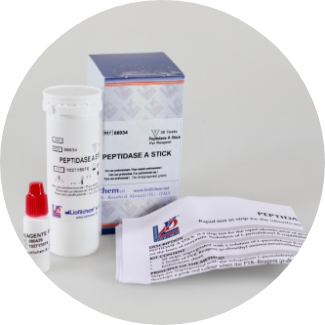Liofilchem® Beta Lactamase Test Kit, 30 Tests
Catalog No :
CAS Number :
Brand :
In Stock
Specifications:
| Application | Microbiology |
| Storage Temperature | 2-8°C |
| Product Type | Biochemical Reagent |
| Product Brand | Liofilchem |
| Product Grade | Microbiology grade |
The Beta Lactamase Test is a rapid diagnostic tool designed to detect the presence of beta-lactamase enzymes in Gram-positive and Gram-negative microorganisms. This enzyme plays a critical role in conferring resistance to penicillins and cephalosporins. It is widely used for clinical and research purposes to evaluate antibiotic resistance profiles, aiding in the diagnosis of infections.
Composition:
- Nitrocefin: Chromogenic cephalosporin that reacts with beta-lactamase to change color from yellow to red.
- Phosphate Buffer: Maintains pH stability while preserving enzymatic activity.
- Dimethyl Sulphoxide (DMSO): Enhances solubility of nitrocefin in the strip matrix.
Intended Purpose:
- Detection: Identifies beta-lactamase production in microorganisms, including Staphylococcus aureus, Haemophilus influenzae, Neisseria gonorrhoeae, and Enterobacteriaceae.
- Applications: Useful in clinical microbiology labs to support decisions in antimicrobial therapy.
Kit Content:
- 30 Test Strips: Individually packaged strips containing nitrocefin.
- Instructions for Use (IFU): Detailed guidelines for testing and result interpretation.
Principle of Operation:
- The test utilizes nitrocefin, a chromogenic cephalosporin substrate. Beta-lactamase activity hydrolyzes the beta-lactam ring of nitrocefin, resulting in a distinct color change from yellow to pink/red.
Instructions for Use:
- Preparation:
- Retrieve the required number of test strips from the freezer and allow them to reach room temperature.
- Inoculation:
- Touch an isolated bacterial colony with a sterile inoculating loop.
- Streak the colony onto the test area of the strip indicated by the arrows.
- Placement:
- Place the inoculated tip of the strip between the lid and base of an inverted Petri dish.
- Ensure adequate moisture is present for the reaction.
- Incubation:
- Incubate at ambient temperature for up to 5 minutes.
- If negative, extend observation to 15 minutes or up to 1 hour for slow-acting organisms like some staphylococci.
Result Interpretation:
- Positive Reaction: Pink/red color indicates beta-lactamase production.
- Negative Reaction: No color change; the strip remains yellow.
Quality Control:
| Control Strains | Reaction |
|---|---|
| Staphylococcus aureus ATCC® 29213 | Positive (pink-red) |
| Haemophilus influenzae ATCC® 35036 | Positive (pink-red) |
| Neisseria gonorrhoeae ATCC® 31426 | Positive (pink-red) |
| Escherichia coli ATCC® 25922 | Negative (no color change) |
Storage and Stability:
- Storage Conditions: Store at -20°C in its original packaging.
- Shelf Life: 1 year.
Performance Characteristics:
- High sensitivity and specificity for beta-lactamase activity.
- Detects enzymes from both Gram-positive and Gram-negative organisms.
- Reliable results within minutes to an hour, depending on bacterial strain.
Limitations:
- False Negatives: Some strains, like beta-lactamase-negative, ampicillin-resistant (BLNAR) H. influenzae, may not produce detectable enzymes.
- False Positives: Some organisms may produce insufficient beta-lactamase to induce a reaction unless pre-exposed to antibiotics like methicillin.
- Additional antimicrobial susceptibility testing is recommended for comprehensive analysis.
Warnings and Precautions:
- For in vitro diagnostic use only.
- Handle all specimens as potentially infectious.
- Ensure proper moisture for accurate results.
- Dispose of used materials according to national and local regulations.
Packaging:
| Product | Packaging | Reference |
|---|---|---|
| Beta Lactamase Test | 30 test strips | 88033 |
References:
- O'Callaghan C.H., et al. (1972). Antimicrob. Agents & Chemother. 1:283-288.
- Shannon K. and Phillips I. (1980). J. Antimicrob. Chemother. 6:617-621.
This test is an essential tool in the identification of beta-lactamase-mediated antibiotic resistance, enabling precise therapeutic interventions.




 0
0
